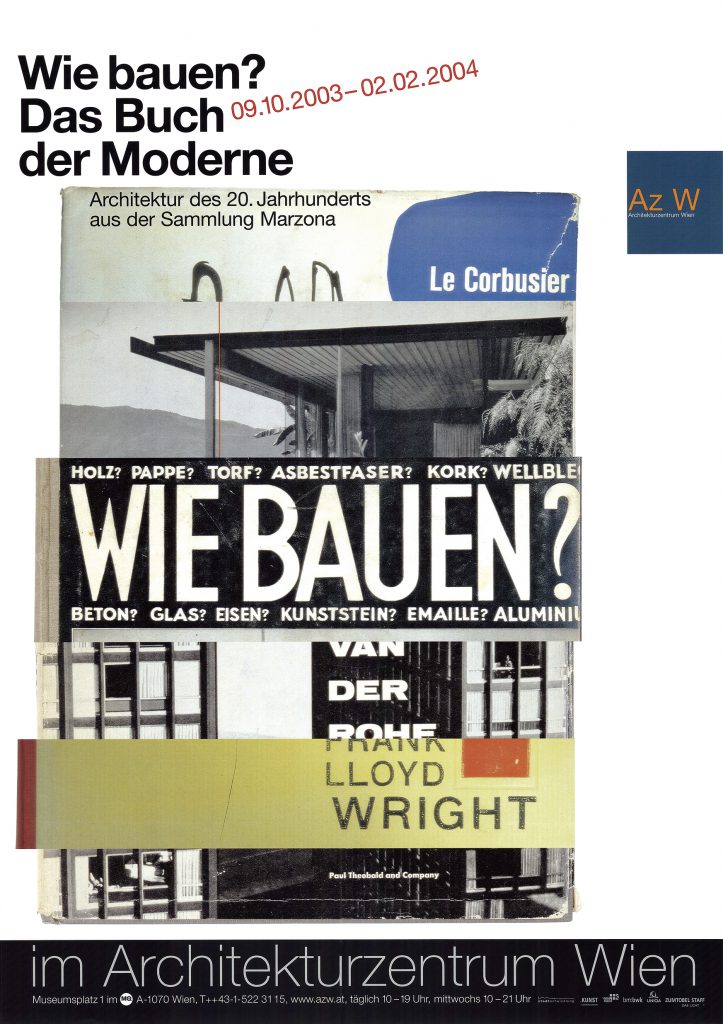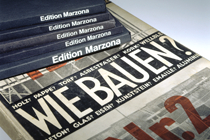Exhibition
How to build? The Modernist Book
Architecture of the 20th Century from the Marzona Collection

Exhibition poster: How to build? The Modernist Book
© Architekturzentrum Wien, graphic design: LIGA: graphic design
Egidio Marzona has a worldwide reputation as an art collector. The Bielefeld-born Italian has been collecting Minimal Art, Arte Povera, Conceptual Art and Land Art since 1968. Only recently part of his collection, comprising over 1000 works of art, was purchased for the Nationalgalerie Hamburger Bahnhof, Museum for Contemporary Art, Berlin.
Less well-known is the fact that Edigio Marzona was early to have also taken an interest in architecture and design. For about 30 years he has been dedicated to research into Bauhaus on the basis of various publications.
The Architekturzentrum Wien now takes great pleasure in being the first institution to be able to introduce the public to the architecture collection of Egidio Marzona. The exhibition is to include approx. 500 publications by, for example, Frank Lloyd Wright, Adolf Behne or Gordon Matta-Clark – i.e. not just publications by architects or theorists, but also by artists who have broken open the boundaries of art and questioned their own relationship to architecture. The significance of the published illustrations for the mediation of modern architecture leads to a shift in accentuation from the pieces of work themselves to their interpretation. At the same time one is reminded of the history of 20th century Modernist architecture, as a manifestation of knowledge and theoretical guiding principles.
Exhibition Talk
Egidio Marzona, Collector
Dietmar Steiner, Director of the Az W
Elisabetta Bresciani, Curator
Marlies Breuss, Michael Ogertschnig, HOLODECK.at
Curator: Elisabetta Bresciani
Project management: Monika Platzer
Exhibition design: HOLODECK.at
Sponsors:
Geschäftsgruppe Stadtentwicklung und Verkehr
Bundeskanzleramt Sektion Kunst
Wien Kultur
Bundesministerium für Bildung, Wissenschaft und Kultur
UNIQA Versicherungen AG
Zumtobel Staff Österreich Vertriebs-GmbH
The exhibition design by the architects HOLODECK.at in the Alte Halle of the Az W adopts the thematic arrangement of the exponents and the dynamic nature of the assorted reading material with flowing walls and hovering volumes of books. An unhierarchic and varied presentation is achieved by means of layering, overlapping and interconnecting the publications on display.
Biography Egidio Marzona
Egidio Marzona was born in 1944 as the third of four siblings in Bielefeld. His grandfather, born at Villa di Verzegnis, Friuli, in1873, was an engineer who built the Alte Schiffshebewerk near Henrichenburg and the Münsterland loch-gates. His father founded a concrete works in Bielefeld after the Second World War. The son was drawn to the artworld. Egidio Marzona ran his own gallery until 1978 in Bielefeld and close to the Dusseldorf Art Academy. The publishing house he founded, Edition Marzona, focussed on research into modernism and Bauhaus. A series of the books published there have long been considered standard reference works – such as the Panamarenko-Publikation, edited by Marzona himself, or his volume of Bauhaus photographs.
Villa di Verzegnis
Egidio Marzona, who knew many of “his” artists personally, was drawn back to Italy at the start of the 1980s. He bought back his own former-family estate in Verzegnis near Udine in Friuli, and tranformed the birthplace of his father and grandfather step by step into a kind of open museum. Egidio Marzona invited artists to work there. Bruce Nauman was the first to do so, with a blunt pyramid that opens the view to the starry sky. Lawrence Weiner, Mario Merz, Sol LeWitt, Dan Graham and Richard Long are others who have left their traces in Marzona’s unique art paradise.
Categories
Around 500 publications from the collection of Egidio Marzona are on show in the exhibition How to Build? The Modernist Book, all together providing detailed comprehensive reading on the architecture of the 20th century, its leitmotifs, ideas and modes of publication.
The publications presented are organised into 8 categories:
Books
At the turn from the 19th to the 20th century reading becomes accessible to a broader public as a result of the development of the machine-manufactured low-cost utility book and of public libraries. New printing processes and a new understanding of typography allow the designers to be more free in their application of formal means.
Education
Innovative educational facilities like those of Bauhaus (Weimar and Dessau) or Wchutemas (Moscow) develop new teaching methods combining theoretical teachings with practical work, and have a major influence on successive institutions, such as the design college in Ulm or the Chicago Institute of Design.
Isms
Back in 1924 Lissitzky questioned the validity of the notion of style and replaced it with the term ‘Ism’. The question as to “in what style we should build” still seems topical. It satisfies a need to divide up architecture into ordered systems, although there is also a permanent attempt to break free of history and the unceasing compulsion to create something new.
Nations
The universal claims of modernity formed the great controversial issue of the 20th century. The broad density of regional and national stock-taking is indicative of the desire to build-up personal identity on the basis of adherence to a national group.
Materials and Construction
The economic and technical changes in the modern age as well as the aesthetic of industrial architecture accelerates new developments in the building sector. Steel, glass and concrete, being suitable for standardisation, become the preferred materials used.
Monographs
Monographs by architects dominate the architecture book market to this day. Beyond the aspects of self-representation involved, the printed word and images generate a significance that the built reality often fails to live up to.
Theory and Practice
Reflections on architecture become increasingly more prominent over the course of the 20th century, and create sustainable positions in the history of architecture. Visions of the future, Utopias or the questioning of existing dogmas preoccupy the historical avant-garde movements, many of whose proponents spread ethical and aesthetic demands.
Urban Development
The planning and the building or redevelopment of a city influence the socio-cultural changes in the structure of society, although these are always dependent on political developments.
Housing Development
The home as the point where a person’s life crystallises is linked inextricably with social, political and economic conditions in a variety of ways, while housing developments are completed as the manifestation of ideologies for the most diverse political positions in the 20th century.
Guided Tours
Saturday, October 11, 2003
3:00 pm
Guides: Elisabetta Bresciani / Egidio Marzona
A guided tour of the exhibition is providing an opportunity to follow a discussion between the curator Elisabetta Bresciani and the collector Egidio Marzona on topics addressed by and relating to the exhibition. As well as questions on the background to the exhibition or the criteria applied to the collection, the contents of the exhibition itself will be explained and discussed in more depth.
Wednesday, November 12, 2003
7:00 pm
Guides: Elisabetta Bresciani / HOLODECK.at
A guided tour of the exhibition is providing an opportunity to follow a discussion between the curator Elisabetta Bresciani and the architects of HOLODECK.at on topics addressed by and relating to the exhibition. The HOLODECK.at design for the exhibition is an architectural contribution in which the publications on display are presented in relationship to one another and arranged according to specific themes.
Alongside explanations of the individual exponents, the issue of the possibilities for exhibition design in general and in this instance in particular is to be addressed.
Wednesday, January 28, 2004
7:00 pm
Guides: Elisabetta Bresciani / Egidio Marzona
A guided tour of the exhibition is providing an opportunity to follow a discussion between the curator Elisabetta Bresciani and the collector Egidio Marzona on topics addressed by and relating to the exhibition. As well as questions on the background to the exhibition or the criteria applied to the collection, the contents of the exhibition itself will be explained and discussed in more depth.


